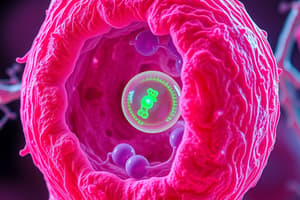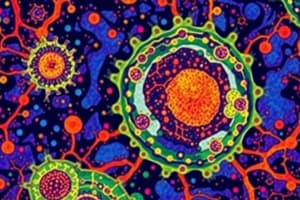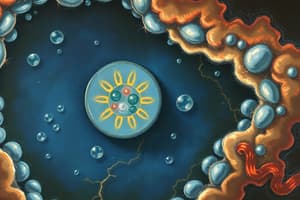Podcast
Questions and Answers
What is the primary function of peroxisomes in a cell?
What is the primary function of peroxisomes in a cell?
- Storing nutrients
- Protein synthesis
- Detoxifying harmful substances (correct)
- Breaking down waste products
Which structure is primarily responsible for synthesizing proteins within the cell?
Which structure is primarily responsible for synthesizing proteins within the cell?
- Lysosome
- Ribosome (correct)
- Nucleus
- Vacuole
What role do nuclear pores serve in the nucleus?
What role do nuclear pores serve in the nucleus?
- Synthesize ribosomes
- Protect genetic material
- Store genetic material
- Allow movement of molecules in and out of the nucleus (correct)
During which stage of protein synthesis is mRNA transcribed from DNA?
During which stage of protein synthesis is mRNA transcribed from DNA?
What is the main purpose of the cell cycle's interphase?
What is the main purpose of the cell cycle's interphase?
How many pairs of chromosomes does a diploid cell contain?
How many pairs of chromosomes does a diploid cell contain?
Which type of RNA is primarily responsible for transferring amino acids during protein synthesis?
Which type of RNA is primarily responsible for transferring amino acids during protein synthesis?
What is the function of the nucleolus within the nucleus?
What is the function of the nucleolus within the nucleus?
What is the primary function of osmosis in cellular processes?
What is the primary function of osmosis in cellular processes?
How does a hypertonic solution compare to a hypotonic solution?
How does a hypertonic solution compare to a hypotonic solution?
What are the primary components of the cytoskeleton?
What are the primary components of the cytoskeleton?
What role does the rough endoplasmic reticulum play in the cell?
What role does the rough endoplasmic reticulum play in the cell?
What is the primary function of the Golgi apparatus?
What is the primary function of the Golgi apparatus?
Which of the following accurately describes the mitochondrion?
Which of the following accurately describes the mitochondrion?
Which statement describes the cytoplasm of a cell?
Which statement describes the cytoplasm of a cell?
What is the primary function of a hypotonic solution in relation to a cell?
What is the primary function of a hypotonic solution in relation to a cell?
What is the primary structural component of the cell membrane?
What is the primary structural component of the cell membrane?
Which type of protein allows large and charged molecules to pass through the cell membrane?
Which type of protein allows large and charged molecules to pass through the cell membrane?
What role does cholesterol play in the cell membrane?
What role does cholesterol play in the cell membrane?
What is the main function of glycoproteins in the cell membrane?
What is the main function of glycoproteins in the cell membrane?
Which process requires ATP to move substances across the cell membrane?
Which process requires ATP to move substances across the cell membrane?
What type of endocytosis involves the uptake of large particles by the cell?
What type of endocytosis involves the uptake of large particles by the cell?
Which of the following accurately describes facilitated diffusion?
Which of the following accurately describes facilitated diffusion?
In exocytosis, how are materials released from the cell?
In exocytosis, how are materials released from the cell?
Flashcards
What is a cell membrane?
What is a cell membrane?
A cell membrane is a phospholipid bilayer that separates the inside of the cell from the outside environment.
What are channel and integral proteins?
What are channel and integral proteins?
Channel proteins allow large and charged molecules to pass through the cell membrane, while integral proteins anchor in the membrane.
What is the role of cholesterol in the cell membrane?
What is the role of cholesterol in the cell membrane?
Cholesterol helps maintain the fluidity, stability, and flexibility of the cell membrane.
What is the function of carbohydrates in the cell membrane?
What is the function of carbohydrates in the cell membrane?
Signup and view all the flashcards
What is simple diffusion?
What is simple diffusion?
Signup and view all the flashcards
What is facilitated diffusion?
What is facilitated diffusion?
Signup and view all the flashcards
What is active transport?
What is active transport?
Signup and view all the flashcards
What is endocytosis?
What is endocytosis?
Signup and view all the flashcards
Osmosis
Osmosis
Signup and view all the flashcards
Hypertonic solution
Hypertonic solution
Signup and view all the flashcards
Isotonic solution
Isotonic solution
Signup and view all the flashcards
Hypotonic solution
Hypotonic solution
Signup and view all the flashcards
Cytosol
Cytosol
Signup and view all the flashcards
Cytoskeleton
Cytoskeleton
Signup and view all the flashcards
Endoplasmic Reticulum (ER)
Endoplasmic Reticulum (ER)
Signup and view all the flashcards
Golgi Apparatus
Golgi Apparatus
Signup and view all the flashcards
What is the nucleus?
What is the nucleus?
Signup and view all the flashcards
What is a lysosome?
What is a lysosome?
Signup and view all the flashcards
What is a ribosome?
What is a ribosome?
Signup and view all the flashcards
What is transcription?
What is transcription?
Signup and view all the flashcards
What is translation?
What is translation?
Signup and view all the flashcards
What is interphase?
What is interphase?
Signup and view all the flashcards
What is mitosis?
What is mitosis?
Signup and view all the flashcards
What is a peroxisome?
What is a peroxisome?
Signup and view all the flashcards
Study Notes
Chapter Objectives
- Students will be able to describe the structure and function of the cell membrane, including its regulation of materials into and out of the cell
- Students will be able to describe the functions of various cytoplasmic organelles
- Students will be able to explain the structure and contents of the nucleus, along with the process of DNA replication
- Students will be able to explain the process by which a cell builds proteins using the DNA code
- Students will be able to list the stages of the cell cycle in order, including the steps of cell division in somatic cells
Mitosis Cell
- A lung cell from a newt was studied.
- The green stain reveals mitotic spindles.
- The red stain corresponds to the cell membrane and part of the cytoplasm.
- The light blue structures are chromosomes.
- The cell is in anaphase of mitosis.
The Cell Membrane
- The cell membrane is a phospholipid bilayer.
- Includes proteins, cholesterol, and carbohydrates.
- Contains many molecular components.
Phospholipid Structure
- The phospholipid molecule consists of a polar phosphate "head" (hydrophilic).
- The phospholipid molecule has a nonpolar lipid "tail" (hydrophobic).
- Unsaturated fatty acids result in kinks in the hydrophobic tails.
- Allows the cell membrane to be selectively permeable.
Phospholipid Bilayer
- The bilayer consists of two adjacent sheets of phospholipids arranged tail to tail
- Hydrophobic tails associate with each other, forming the membrane's interior
- Polar heads contact the fluid inside and outside the cell.
Cell Membrane - Proteins
- Channel proteins allow large and charged molecules to pass through the membrane
- Integral proteins anchor the cell membrane
- Glycoproteins are involved in cell recognition and signaling
Cell Membrane - Cholesterol
- Helps with cell fluidity, stability, and flexibility.
Cell Membrane - Carbohydrates
- Enables cell-to-cell recognition and signaling
- Glycocalyx is important in cell protection against pathogens.
- Formed by glycoproteins and glycolipids.
Simple Diffusion
- Non-polar substances like oxygen and carbon dioxide, and lipids diffuse down their concentration gradient.
- No helper proteins or ATP are needed.
Facilitated Diffusion
- Helper proteins, such as channel proteins, facilitate the movement of large and charged molecules like ions, amino acids, and glucose down their concentration gradient.
- No ATP is required.
Active Transport
- Requires a helper protein and ATP.
- Substances such as sodium and potassium move against their concentration gradient.
- The sodium-potassium pump is a typical example of active transport.
Endocytosis
- A form of active transport where a cell envelopes extracellular materials using its cell membrane.
- Phagocytosis is a non-selective process for engulfing large particles .
- In pinocytosis, the cell takes in small particles in fluid .
- Receptor-mediated endocytosis is a specific process.
Exocytosis
- Exocytosis is essentially endocytosis in reverse.
- Material destined for export is packaged into vesicles within the cell.
- The vesicle membrane fuses with the cell membrane.
- The contents of the vesicle are then released into the extracellular space.
Osmosis
- The diffusion of water (movement) through a semipermeable membrane down its concentration gradient.
- Water follows solute through the membrane
Tonicity
- Hypertonic solution has a higher solute concentration than another
- Isotonic solution has an equal solute concentration to another
- Hypotonic solution has a lower solute concentration than another
The Cytoplasm and Cellular Organelles
- The cytoplasm is the fluid portion of the cell, excluding organelles.
- The cytoplasm is involved in cell structure and metabolic reactions
- The cytoplasm contains cytoskeleton
Prototypical Human Cell
- Includes mitochondria, plasma membrane, ribosomes, rough endoplasmic reticulum, nucleus, nucleolus, chromatin, Golgi apparatus, Golgi vesicles, cytoplasm, vacuole and others
- A prototypical example of a cell with primary organelles and internal structures.
Cytoskeleton
- Consists of microtubules, microfilaments, and intermediate filaments.
- Plays a crucial role in maintaining cell shape, promoting cellular movement, and aiding cell division.
Endoplasmic Reticulum (ER)
- A winding network of thin membranous sacs found in close association with the cell nucleus.
- Rough ER makes protein, with ribosomes attached.
- Smooth ER makes lipids.
- No ribosomes are attached to the smooth ER.
Golgi Apparatus
- Manipulates products from the rough ER and produces new organelles (e.g., lysosomes)
- Organizes, modifies, packages, and tags proteins and other products.
- Some products are transported to other parts of the cell; others are exported via exocytosis.
Mitochondrion
- Powerhouse of the cell.
- Bilayer membrane, inner membrane contains various molecules to produce ATP.
Membrane-bound Structures
- Peroxisomes contain enzymes for detoxifying harmful substances and lipid metabolism.
- Lysosomes break down waste products.
- Vacuoles store nutrients and waste
Ribosome
- Made in the nucleus and synthesizes proteins.
- Works with mRNA and tRNA.
- Can be found in the RER or in cytosol
The Nucleus and DNA Replication
- The nucleus is the control centre of the cell.
- Contains genetic material to control structure and function.
Nucleus
- Control center of the cell
- Contains the genetic material (DNA) determines the entire structure and function of the cell.
- DNA & proteins in chromatin are stored
- Site of ribosome production (nucleolus)
Nucleic acids
- RNA (key to protein synthesis): mRNA, rRNA, tRNA
- mRNA delivers instructions to ribosomes
- tRNA carries amino acids to ribosomes
- rRNA forms part of the ribosome structure
Transcription
- In the first stage of protein synthesis, a gene on the DNA molecule is transcribed into a complementary mRNA molecule.
Translation
- mRNA transcript is read by a functional complex (ribosome and tRNA molecules).
- tRNAs bring the appropriate amino acids.
Cell Growth and Division
- The cell cycle consists of mitosis (cell division) and interphase (cell growth and normal functions).
- Diploid cells have 23 pairs of chromosomes (46 chromosomes total)
Meiosis
- A cell divides twice to form four cells with half the genetic information (2n → n).
- Meiosis forms sperm and egg.
Anaerobic vs Aerobic Respiration
- Anaerobic respiration occurs in the absence of oxygen and converts glucose into two lactate molecules.
- Aerobic respiration takes place in the presence of oxygen, converting glucose into two pyruvate molecules
Glycolysis
- Two ATPs are consumed in glycolysis’ energy-consuming phase.
- Transforms glucose into two pyruvate molecules.
Krebs Cycle
- Each pyruvate is oxidized to a two-carbon acetyl-CoA molecule.
- Acetyl-CoA is processed through the cycle.
Oxidative Phosphorylation
- Includes electron transport chain and ATP synthesis, using H+ concentration gradient to generate ATP.
- Oxygen is the final electron acceptor.
ETC Key Takeaway
- NADH and FADH2 donate electrons and protons to the electron transport chain.
- Protons from the electron transport complexes move into the intermembrane space.
- This creates a gradient needed to power ATP synthase, leading to ATP production.
- Oxygen is the final electron acceptor., producing water.
Carbohydrate Metabolism Summary
- Involves glycolysis, Krebs cycle, and the electron transport system.
- Total ATP production varies with efficiency.
Studying That Suits You
Use AI to generate personalized quizzes and flashcards to suit your learning preferences.




